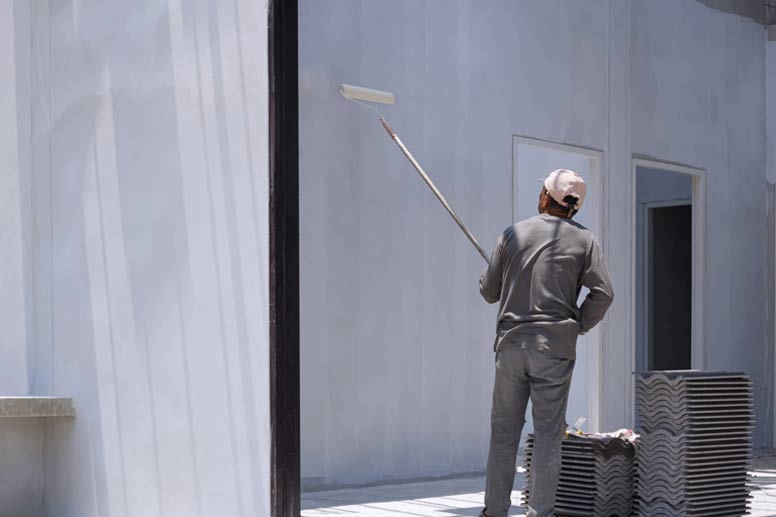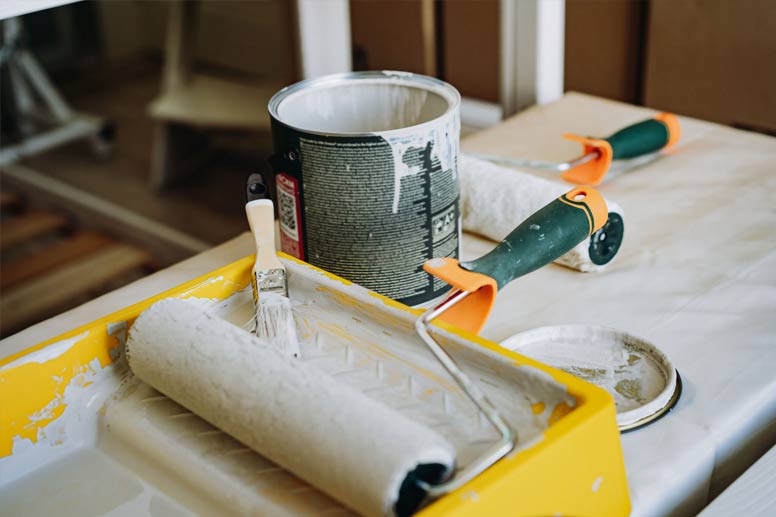How to Get a Painting Business License in the United States

Table of Contents
If you’re thinking about starting your own painting business or taking on bigger projects, you might be wondering, “Do I need a license to paint houses?”
The short answer: it depends. Your state, the kind of work you’re doing, and the size of your projects all play a role. Some states don’t require a painting license for smaller jobs, but getting licensed can really set you apart. It opens doors to larger contracts, gives clients peace of mind, and shows that you’re a true professional.
Licensed painters also tend to earn more. According to the Bureau of Labor Statistics (BLS) report, licensed contractors in construction and related fields can earn up to 20% more than their unlicensed peers.
Why? Clients trust licensed pros because it shows you know what you’re doing and follow the rules. In fact, in California, a license is legally required for any project that costs more than $500 in labor and materials.
States like California even mandate that painters have a license for any project exceeding $500 in labor and materials.
In this guide, we’ll walk you through how to get licensed as a painter. Whether you’re aiming to boost your credibility or tackle bigger jobs, this is your step-by-step plan to get your license and grow your painting career or business.
Why Get a Painting License?
A painting license is more than just a formality. It’s a game-changer for building trust and growing your business. Being a licensed painting contractor opens the door to high-paying opportunities, like commercial projects and government contracts, where a license is often a must to bid.
For homeowners, hiring a licensed painter means peace of mind. It shows that you’ve met state standards for safety, quality, and professionalism. Plus, many licenses require insurance, which protects both you and your clients from unexpected issues. It’s a win-win that boosts your credibility and reduces liability.
John, a painter in California, discovered that obtaining his painting contractor license transformed his business. It not only enabled him to take on larger projects but also gave his business a polished, professional reputation.
Clients began showing more trust and confidence in his work, and the license became a pivotal factor in elevating his career. According to John, the license wasn’t just a formality—it was a true game-changer that set him apart from the competition.
RELATED ARTICLE: How To Start A Painting Business

Do I Need a License to Start a Painting Business?
In most states, you don’t need a license to start a painting business if you’re sticking to small residential projects.
But if you’re planning to take on bigger jobs, like commercial painting or projects that exceed a certain dollar amount (usually between $500 and $1,000), a license is typically required.
Here’s a look at a few key states:
- In California, any job over $500 requires a painting license.
- In Florida, painting contractors need a state-issued license for both residential and commercial work.
- In Michigan, a commercial painting license is required for projects exceeding $600.
Even in states where a license isn’t mandatory, having one can set your business apart. It builds trust with clients and shows you’re serious about your craft, making it easier to land bigger and better projects.
RELATED ARTICLE: How Much Do Painters Make?

How to Get Licensed as a Painter
Getting a painting license may seem overwhelming, but it’s a straightforward process when you break it down.
Requirements vary depending on where you live, but here’s a closer look at the typical steps to get licensed:
1. Research Your State’s Requirements
Start by finding out what your state expects from painters. Some states require you to pass an exam, while others might only need proof of insurance and business registration.
Check your state’s contractor licensing board or department of business regulation for the exact details. For example, California has strict requirements for projects over $500, while Michigan focuses more on commercial work over $600.
2. Meet Experience and Education Requirements
Many states want to ensure you’re experienced before issuing a license. Most require two to four years of work experience as a painter, and some may also ask you to complete a contractor training course. In Florida, for instance, you’ll need a mix of experience and education to qualify for the exam.
3. Pass a Licensing Exam
In states like California and Florida, you’ll need to pass a licensing exam that covers essential topics like safety protocols, building codes, and business practices. These exams ensure you’re prepared for the challenges of running a painting business and following local regulations.
4. Submit Your Application
Once you’ve met the requirements, you’ll need to complete a detailed application. This typically includes your personal information, proof of experience, and business details.
Having your paperwork organized ahead of time—like insurance certificates and employment history—will make this step much easier.
5. Pay the Licensing Fee
Licensing fees vary but usually range from $50 to $300, depending on the state. While this may seem like an added cost, it’s a worthwhile investment in your career.
6. Maintain Your License
Your work doesn’t end once you’re licensed. Most states require you to renew your license every one to three years. This usually involves paying a renewal fee, providing proof of insurance, and completing continuing education to stay updated on industry practices.
Tip! Tools like our Estimate App or our Estimate Generator can help you stay organized by keeping track of job details and expenses. Having everything in order makes the application and renewal process much smoother.
RELATED ARTICLE: How Much Do Painters Charge?
How Much Does a Painting License Cost?
The cost of a painting license depends on your state. Here’s a breakdown of average costs:
- Application Fees: $50 to $150
- Exam Fees: $60 to $150
- Renewal Fees: $50 to $300 every 1–3 years
For example, getting a painting contractor license in California requires paying an initial application fee of $450 and a renewal fee of $450 every two years.
In Michigan, the total cost to get a commercial painting license is around $200, including application and renewal fees.
RELATED ARTICLE: How To Get Your Painting Insurance

State-Specific Licensing Requirements
Painting license rules vary by state. Some are strict, while others have no requirements at all. Even if it’s not mandatory where you live, getting licensed boosts your credibility, helps you land bigger jobs, and shows clients you’re a pro.
Here’s an in-depth look at licensing requirements in several states and why they matter:
California
California is known for its strict licensing rules to protect consumers and ensure quality work. The California Contractors State License Board (CSLB) is the governing body, and licenses are required for any project costing more than $500 in labor and materials. To get a painting license, you must:
- Be at least 18 years old.
- Have at least four years of work experience in painting or a related trade.
- Pass the California Contractor License exam, which covers topics like safety, business practices, and building codes.
- Provide proof of liability insurance and, in most cases, worker’s compensation insurance if you employ others.
Florida
In Florida, a painting license is required for all commercial and residential work. Licenses are regulated by the Florida Department of Business and Professional Regulation. The process there involves:
- Passing a business and law exam to ensure you understand Florida’s construction laws.
- Providing proof of liability insurance, typically a minimum of $300,000 for bodily injury and $50,000 for property damage.
- Completing an application and paying fees of around $250.
Michigan
Michigan requires a commercial painting license for larger projects. The Department of Licensing and Regulatory Affairs (LARA) oversees licensing in Michigan. To qualify, you must:
- Have at least two years of experience in painting or a related field.
- Submit proof of insurance and worker’s compensation coverage.
- Pay application and licensing fees, which typically total around $200.
Texas
Texas does not require a state-issued painting license for most work. However, certain municipalities, like Houston and Dallas, may have local licensing or registration requirements.
While state-level licenses are not mandatory, obtaining certifications, like OSHA safety training, can boost your credibility and earnings potential.
New York
New York also doesn’t have a statewide painting license, but many cities, such as New York City, require contractors to be registered. NYC contractors often need to provide proof of insurance and pass a background check to meet city standards.
Alabama
Alabama requires a license for painting projects exceeding $50,000. The Alabama Licensing Board for General Contractors handles all applications. To qualify, applicants must:
- Pass an exam covering building codes and business law.
- Provide proof of liability insurance and worker’s compensation coverage.
- Pay a licensing fee of around $300.
Pennsylvania
Pennsylvania doesn’t require a license for painters at the state level, but many cities, such as Philadelphia, require contractors to register. This process often includes providing proof of insurance and paying a small fee.
Benefits of Becoming a Licensed Painter
As you have gathered by now, getting licensed as a painter isn’t just about following the rules—it’s a smart move that can take your business to the next level. Here are some key benefits of becoming a licensed painter:
Access to Larger Jobs
A license opens doors to commercial projects, government contracts, and high-value residential work that you can’t bid on without proper credentials. These jobs often come with bigger budgets and long-term opportunities.
Client Trust
Homeowners and businesses feel more confident hiring licensed painting contractors because it shows you’re qualified, professional, and accountable. A license can be the deciding factor that gets you hired over unlicensed competitors.
Reduce Liability
Most licensing requirements include having insurance, which protects both you and your clients. From accidental spills to unexpected property damage, being insured under your license adds an extra layer of security.
Lisa, a painter in Florida, saw these benefits firsthand. After getting her painting contractor license, she was able to bid on commercial jobs she’d never qualified for before. “It’s opened up a whole new level of opportunities,” she says, noting how it helped her build trust with clients and secure higher-paying work.

Tools to Simplify the Licensing Process
Staying organized during the licensing process is crucial. Tools like Painting Contractor Software can make managing your business easier:
- The Invoice Maker helps you create professional invoices to show proof of income.
- The Receipt Scanner keeps track of expenses, which can be useful for license applications.
- The Client Portal allows you to showcase your work and communicate effectively with clients.
Final Thoughts
Getting a painting license might feel like a lot of work, but it’s one of the best moves you can make for your career or business. It’s not just about following the rules—a license opens the door to bigger, better-paying jobs, helps you stand out from unlicensed competitors, and shows clients they can trust you.
Plus, it protects you and your business from potential risks, which is always a bonus.
Whether you’re looking to get a commercial painting license in Michigan, navigate California’s strict rules, or grow your painting business anywhere in the U.S., this guide has you covered.
Take it step by step. Research what’s required, gain experience, pass the exams, and stay on top of renewals. Once you’re licensed, you’ll be ready to take on bigger projects, attract more clients, and build a business that lasts.
And remember, having the right tools can make running your painting business smoother. From organizing paperwork to tracking expenses, our Software for Painting Contractors is designed to help you succeed.
Ready to get started?
Download Invoice Fly today!
